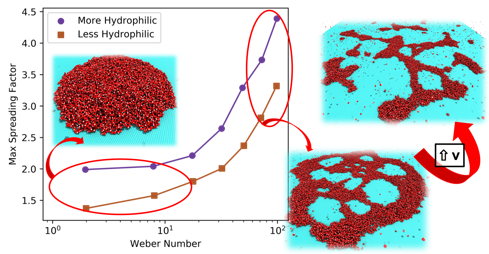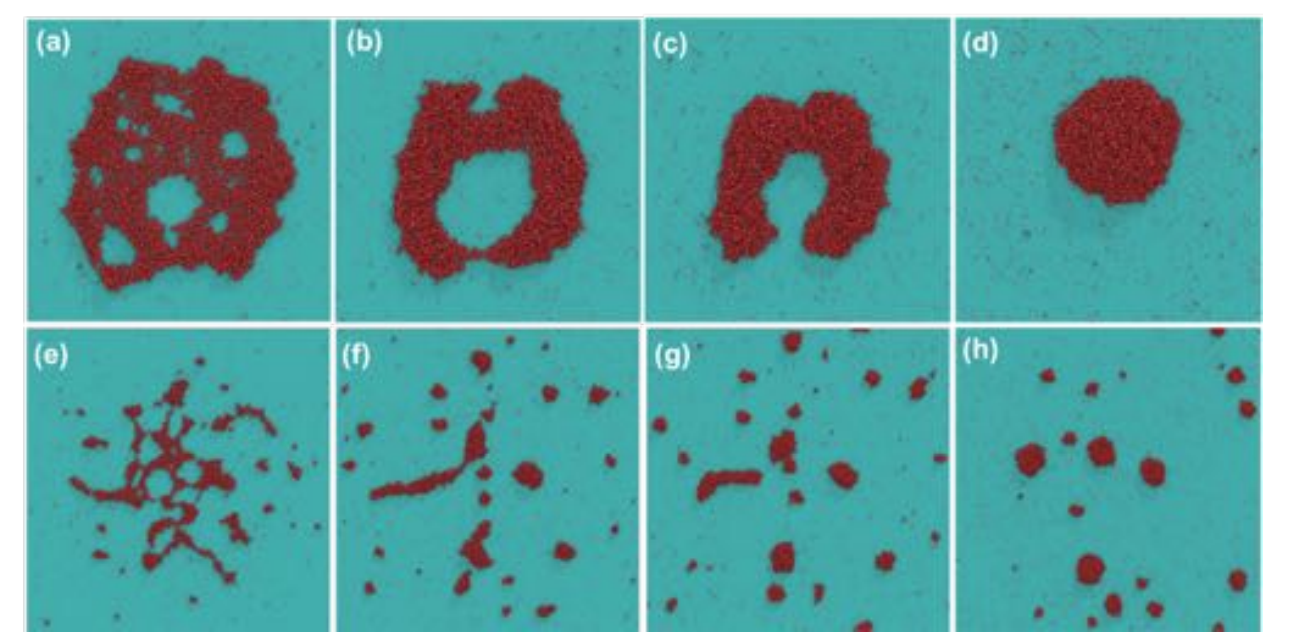Jaques, Ygor M.; Galvao, Douglas S.
Structural Properties of Nanodroplets Impacting Graphene at High Velocities (accepted) Journal Article
In: Journal of Molecular Liquids, 2019.
@article{Jaques2019b,
title = {Structural Properties of Nanodroplets Impacting Graphene at High Velocities (accepted)},
author = {Ygor M. Jaques and Douglas S. Galvao},
year = {2019},
date = {2019-02-05},
journal = {Journal of Molecular Liquids},
abstract = {The determination of the wettability of 2D materials is an area of intensive research, as it is decisive on the applications of these systems in nanofluidics. One important part of the wetting characterization is how the spreading of droplets impacting on the surfaces occurs. However, few works address this problem for layered materials. Here, we report a fully atomistic molecular dynamics study on the dynamics of impact of water nanodroplets (100 ̊A of diameter) at high velocities (from 1 up to 15 ̊A/ps) against graphene targets. Our results show that tuning graphene wettability (through parameter changes) significantly affects the structural and dynamical aspects of the nanodroplets. We identified three ranges of velocities with distinct characteristics, from simple deposition of the droplet to spreading with rebound, and finally droplet frag- mentation. We also identify that in an intermediary velocity of 7 ̊A/ps, the pattern of spreading critically changes, due to formation of voids on droplet structure. These voids affect in a detrimental way the droplet spreading on the less hydrophilic surface, as it takes more time to the droplet recover from the spreading and to return to a semi-spherical configuration. When the velocity is increased to values larger than 11 ̊A/ps, the droplet fragments, which reveals the maximum possible spreading.},
keywords = {},
pubstate = {published},
tppubtype = {article}
}
Ygor M.; Galvao Jaques, Douglas S.
Structural Properties of Nanodroplets Impacting Graphene at High Velocities Online
2018, (Preprint ArXiv:1804.07784).
@online{Jaques2018d,
title = {Structural Properties of Nanodroplets Impacting Graphene at High Velocities},
author = {Jaques, Ygor M.; Galvao, Douglas S.},
url = {https://arxiv.org/abs/1804.07784},
year = {2018},
date = {2018-04-24},
abstract = {We report here a fully atomistic molecular dynamics study on the dynamics of impact of water
nanodroplets (50, 100 and 120 Å of diameter) at high velocity (from 100 up to 1000 m/s) against
graphene targets. Our results show that tuning graphene wettability (through parameter changes)
significantly affects the structural and dynamical aspects of the nanodroplets. We identified three
ranges of velocities with distinct characteristics, from simple deposition of the droplet to
spreading with rebound and finally fragmentation. At Weber numbers lower than 10, the droplets
maintain a steady spreading factor independent of size. After this threshold value, the spread
rapidly grows with increasing Weber numbers. A more hydrophilic graphene surface increases
the spreading values, due to stronger solid-liquid interactions. Nevertheless, droplet size also
influences the fragmentation threshold, as an increased number of molecules make it easier for
the whole droplet overcomes the surface repulsion. },
note = {Preprint ArXiv:1804.07784},
keywords = {},
pubstate = {published},
tppubtype = {online}
}
nanodroplets (50, 100 and 120 Å of diameter) at high velocity (from 100 up to 1000 m/s) against
graphene targets. Our results show that tuning graphene wettability (through parameter changes)
significantly affects the structural and dynamical aspects of the nanodroplets. We identified three
ranges of velocities with distinct characteristics, from simple deposition of the droplet to
spreading with rebound and finally fragmentation. At Weber numbers lower than 10, the droplets
maintain a steady spreading factor independent of size. After this threshold value, the spread
rapidly grows with increasing Weber numbers. A more hydrophilic graphene surface increases
the spreading values, due to stronger solid-liquid interactions. Nevertheless, droplet size also
influences the fragmentation threshold, as an increased number of molecules make it easier for
the whole droplet overcomes the surface repulsion.
2019

Jaques, Ygor M.; Galvao, Douglas S.
Structural Properties of Nanodroplets Impacting Graphene at High Velocities (accepted) Journal Article
In: Journal of Molecular Liquids, 2019.
Abstract | BibTeX | Tags: droplets, Graphene, Impact Molecular Dynamics, water
@article{Jaques2019b,
title = {Structural Properties of Nanodroplets Impacting Graphene at High Velocities (accepted)},
author = {Ygor M. Jaques and Douglas S. Galvao},
year = {2019},
date = {2019-02-05},
journal = {Journal of Molecular Liquids},
abstract = {The determination of the wettability of 2D materials is an area of intensive research, as it is decisive on the applications of these systems in nanofluidics. One important part of the wetting characterization is how the spreading of droplets impacting on the surfaces occurs. However, few works address this problem for layered materials. Here, we report a fully atomistic molecular dynamics study on the dynamics of impact of water nanodroplets (100 ̊A of diameter) at high velocities (from 1 up to 15 ̊A/ps) against graphene targets. Our results show that tuning graphene wettability (through parameter changes) significantly affects the structural and dynamical aspects of the nanodroplets. We identified three ranges of velocities with distinct characteristics, from simple deposition of the droplet to spreading with rebound, and finally droplet frag- mentation. We also identify that in an intermediary velocity of 7 ̊A/ps, the pattern of spreading critically changes, due to formation of voids on droplet structure. These voids affect in a detrimental way the droplet spreading on the less hydrophilic surface, as it takes more time to the droplet recover from the spreading and to return to a semi-spherical configuration. When the velocity is increased to values larger than 11 ̊A/ps, the droplet fragments, which reveals the maximum possible spreading.},
keywords = {droplets, Graphene, Impact Molecular Dynamics, water},
pubstate = {published},
tppubtype = {article}
}
2018

Ygor M.; Galvao Jaques, Douglas S.
Structural Properties of Nanodroplets Impacting Graphene at High Velocities Online
2018, (Preprint ArXiv:1804.07784).
Abstract | Links | BibTeX | Tags: droplets, Graphene, Impact Molecular Dynamics, water
@online{Jaques2018d,
title = {Structural Properties of Nanodroplets Impacting Graphene at High Velocities},
author = {Jaques, Ygor M.; Galvao, Douglas S.},
url = {https://arxiv.org/abs/1804.07784},
year = {2018},
date = {2018-04-24},
abstract = {We report here a fully atomistic molecular dynamics study on the dynamics of impact of water
nanodroplets (50, 100 and 120 Å of diameter) at high velocity (from 100 up to 1000 m/s) against
graphene targets. Our results show that tuning graphene wettability (through parameter changes)
significantly affects the structural and dynamical aspects of the nanodroplets. We identified three
ranges of velocities with distinct characteristics, from simple deposition of the droplet to
spreading with rebound and finally fragmentation. At Weber numbers lower than 10, the droplets
maintain a steady spreading factor independent of size. After this threshold value, the spread
rapidly grows with increasing Weber numbers. A more hydrophilic graphene surface increases
the spreading values, due to stronger solid-liquid interactions. Nevertheless, droplet size also
influences the fragmentation threshold, as an increased number of molecules make it easier for
the whole droplet overcomes the surface repulsion. },
note = {Preprint ArXiv:1804.07784},
keywords = {droplets, Graphene, Impact Molecular Dynamics, water},
pubstate = {published},
tppubtype = {online}
}
nanodroplets (50, 100 and 120 Å of diameter) at high velocity (from 100 up to 1000 m/s) against
graphene targets. Our results show that tuning graphene wettability (through parameter changes)
significantly affects the structural and dynamical aspects of the nanodroplets. We identified three
ranges of velocities with distinct characteristics, from simple deposition of the droplet to
spreading with rebound and finally fragmentation. At Weber numbers lower than 10, the droplets
maintain a steady spreading factor independent of size. After this threshold value, the spread
rapidly grows with increasing Weber numbers. A more hydrophilic graphene surface increases
the spreading values, due to stronger solid-liquid interactions. Nevertheless, droplet size also
influences the fragmentation threshold, as an increased number of molecules make it easier for
the whole droplet overcomes the surface repulsion.
http://scholar.google.com/citations?hl=en&user=95SvbM8AAAAJ


